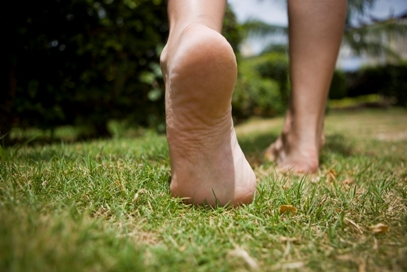
Since Christopher McDougall’s Born to Run, the running community has embraced minimalism and barefoot running. It’s not a fad or a passing trend – it’s here to stay.
And for good reason: wearing less shoe can help you refine your running form, improve your efficiency, reduce the risk of injury, and make running more interactive. Who doesn’t want all of that?
Major shoe manufacturers are taking notice and introducing lighter shoes that are closer to the ground. Online retailers have “minimalist” running shoe categories.
The people have spoken and want to return to simplicity. I couldn’t be happier. The science, personal testimonials, and anecdotal evidence supporting barefoot running and minimalism is enough to convince me it’s a worthy training tool that every runner should implement in their program.
To bring more light to the subject, I reached out to several running bloggers and asked them to participate in the first Minimalist Running Blog Carnival. I was met with a lot of enthusiasm and am proud to host a collection of articles on the topic of minimalist running:
The Evolutionary Basis for Minimalist Running
David Csonka explores the primitive reasons that barefoot running is the preferred way to move for humans. He says, “It is your evolutionary birthright to run free and unrestrained. It’s what your body was naturally engineered to do.” If you have your doubts about this whole “barefoot thing” and want more convincing, read this article first.
Minimalism and Ultrarunning
Ultramarathoner Donald Buraglio combines minimalism with ultra endurance. Here’s your teaser:
“Conventional wisdom in the ultra community seems to say that minimalist running is fine for short distances or easy terrain, but for big mileage on challenging technical trails, you need shoes that are rugged enough to protect your feet from taking a beating. I can attest that such claims are simply bogus.”
Wrong
Matt Wilson, commonly known as Luau from his website Run Luau Run, recounts his transition to minimalist running with his Vibram FiveFingers. Luau includes the biggest mistake he made when he first began his minimalist journey, the price he paid, and the lessons he learned. This is a great read for a beginner who wants to know what mistakes to avoid.
Stride Rate, Stride Length, Overstriding, and Minimalist Running Form
Pete Larson writes about the recent discussion in the running community about stride rate (how many steps you take per minute), stride length, and its relationship to minimalist running. With his experience reviewing a lot of shoes and teaching anatomy at the college level, Pete offers a unique perspective on minimalist running shoes and how it can help you prevent injuries.
Focus on Form – The Goal of Minimalist Running
Greg Strosaker has been transitioning to less shoe for about a year now. Instead of advocating minimalism for every runner, Greg maintains that every runner has different needs and can benefit from making small adjustments in running form with the help of minimalist techniques and an evaluation of your strengths and weaknesses.
##
A big THANK YOU to the runners and writers who contributed to the Minimalist Running Blog Carnival. Please check out their articles, let us know your thoughts and own experiences with minimalist running, and if you have any questions!
If you liked these articles, please share this round-up and subscribe to the blogs that are mentioned. Us bloggers love interacting with new readers!